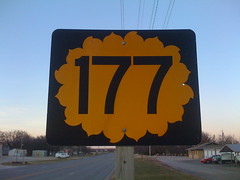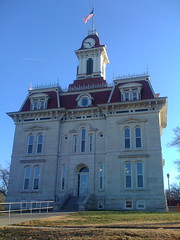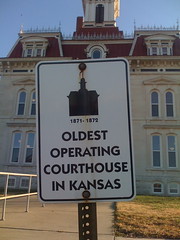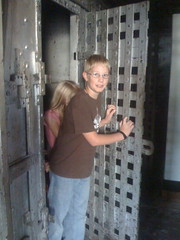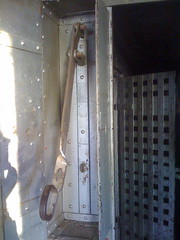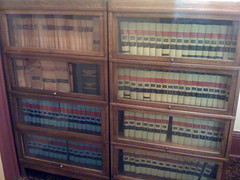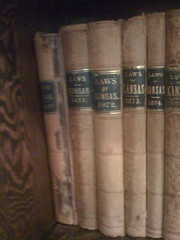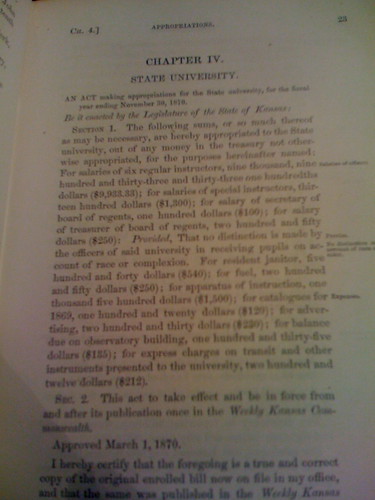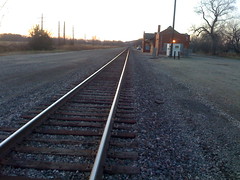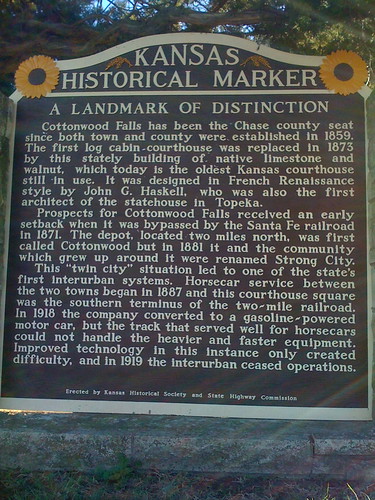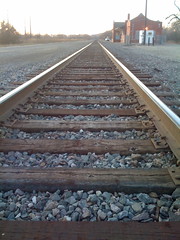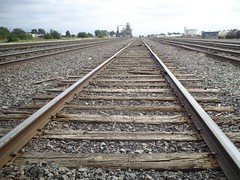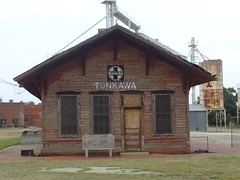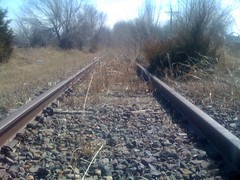Yesterday was our 2008 family Thanksgiving travel day, as we ventured from our home in Oklahoma to “grandmother’s house” in Manhattan, Kansas.
There are three basic routes we take when we drive up to Manhattan, which all involve Interstate 35. Yesterday, since we had plenty of time, we opted for the prettiest route which takes us up K-177.
K-177 has officially been designated the “Flint Hills National Scenic Byway,” and has an area just north of the I-35 turnpike and south of Matfield Green which I maintain is the prettiest stretch of highway in the entire Sunflower State. According to WikiPedia, incidentally Matfield Green:
…has a total area of 0.2 square miles (0.5 km²)… As of the census of 2000, there were 60 people, 31 households, and 18 families residing in the city.
The smallest western town I’ve ever visited, I think, is Tie Siding, Wyoming. Matfield Green is comparatively a bustling metropolis!
Thanks to the radio broadcast system (1680 AM) on the byway, we started learning about Cottonwood Falls before we actually arrived in town. Cottonwood Falls has the distinction of not only being the county seat of Chase County, Kansas, but also having the oldest operating courthouse in the state of Kansas.
The courthouse has been in continuous operation since 1872, but just underwent 18 months of interior renovation. The county employees moved back in about a month and a half ago. Photos from the Chase County Courthouse “Restoration Celebration & Open House” on Saturday, October 25, 2008, are available on the official Chase County website. We just happened to have a chance to stop in and tour the courthouse yesterday, and learned a great deal thanks to the exceptionally helpful county appraiser.
The interior of this striking limestone edifice is accented most dramatically by a self-supporting staircase made of local Kansas walnut.
We were most impressed, however, by the historical Chase County jail located on the 2nd floor in the back of the courthouse.
This large handle was used (and still works) to lock all the cells inside the jail structure:
According to the metal label on the outside of the jail, this lever-based locking mechanism was patented in 1874 by P.J. Pauly and Bro. in Saint Louis, Missouri.
This jail replaced the first jail in Cottonwood Falls, which was in operation from 1870 to 1873:
I snapped the following photo from the original jail’s window. There is a drawing of Billy the Kid on the bars, so apparently there was a historical connection to him. I don’t know more details about that, however. (If you do, please comment and provide any links you can.)
One of the more interesting aspects of the historical jail in the courthouse was the graffiti inside and around it.
Amazingly, this jail was used from 1874 until the early 1970s, around 1974. I wonder how many other Kansas counties used the same jail for 100 years? Apparently one of the former jail residents was named Wes!
It was SO COOL to be able to explore and examine this jail which is over 100 years old!
My family can vouch that the 1874-patented jail locking lever system still works!
In addition to the jail, I found the set of law books in the back of the Chase County courthouse to be fascinating.
This photo shows the oldest volumes of Kansas statutes in the collection. The oldest one is from 1870:
Consider the size of that thin volume, compared to the “General Statutes of Kansas” from 1949:
This is a very visual way to see how our legal code / law system has grown in the past 100+ years.
The 1870 legal statutes book includes the following page for salaries at the “state university,” which was/is Kansas State University:
“For salaries of six regular instructors” the statute provided “$9,933.33.” If equally divided, that amounted to $1655 per year each. University salaries have changed quite a bit in the past century!
I will conclude this post of historical storychasing with some images and reflections on railroads.
The history of Cottonwood Falls was altered forever in the 1871 when the Santa Fe railroad bypassed the town and instead established a depot in nearby Strong City, just two miles to the north.
According to the historical sign in front of the Chase County courthouse in Cottonwood Falls, this decision to put the railroad stop in Strong City led to a “twin-city” relationship between the two towns and the establishment of one of Kansas’s first “interurban” railcar systems for public transportation.
I reflected on the similarities of importance between rail line infrastructure in the United States and high-speed Internet connections in my fourth podcast recorded on August 18, 2005, “Netflix – Google RSS Research – Trails, Trains, and T-1s.” The importance and implications of U.S. towns and cities being connected or bypassed by rail lines, Interstate highways, and now high-speed fiber optic connections to the information superhighway is reflected in a fun way in Pixar’s 2006 film “Cars.” The commercial viability of the film’s fictional town of “Radiator Springs” was decimated when it was bypassed by Interstate 40, almost eliminating the town’s geographic visibility thanks in the past to the historic “mother road” Route 66.
In the same way that the decision for the Santa Fe railroad to bypass Cottonwood Falls had profound economic implications for the community, the failure of many state and local governments (to date) to bring high speed, fiber optic connectivity to the Internet to rural communities has important economic and cultural implications as well. This is a photo I snapped yesterday in Cottonwood Falls of their local AT&T central office / telephone exchange. Seeing this central office and thinking about both historical as well as contemporary infrastructure connections in the midwest made me think more about these issues.
In April 2008, our family rode the Heartland Flyer train from Oklahoma City to Fort Worth. In reading the current WikiPedia article for Strong City, I was delighted to learn a proposal has been submitted to possibly connect the town (and eventually Kansas City) to Oklahoma City via the Heartland Flyer:
The small Kansas town surprised many communities when it announced its intensions to apply for an Amtrak station on Amtrak’s proposed extension of the Heartland Flyer from Oklahoma City to Kansas City, Missouri. If the town should receive a station it would be one of the smallest towns in the Amtrak system to have a station.
What fun it would be to be able to ride a train almost all the way to grandmother’s house in Kansas! 🙂
This past summer, we visited Dalhart, Texas (where we have historical family connections) for the XIT Rodeo and Reunion, and that trip also provided time to think about railroad and Internet infrastructure comparisons.
I wrote the post “Railroads and virtual connections” on August 20th addressing these issues. Whenever I see rail lines and small communities, whether they are in rural Kansas, Oklahoma, or Texas, my mind naturally turns to the implications of historical as well as contemporary infrastructure connections. This is the now abandoned, train depot in Tonkawa, Oklahoma:
This is the now abandoned rail line in Crescent, Oklahama:
When leaders of the United States recognized our need to provide electricity to EVERY citizen of our nation, they did not sit back to wait till companies made ROI calculations which justified the expensive infrastructure build-out which was required. Groups like the TVA were formed precisely because commercial corporations would NOT, left to themselves and “market incentives,” choose to provide commercial electricity services to many rural areas EVER. The same dynamics are present today with respect to fiber-based, high-speed Internet connectivity. While the E-Rate program has certainly provided greater levels of connectivity for U.S. schools and libraries, it HAS not and is not designed to provide the sort of high speed connectivity which our rural communities require today in 2008. E-Rate was established as a result of lobbying efforts by many groups. Its principal financial beneficiaries are, however, large telecommunications companies. These companies do NOT encourage schools to build-out or utilize “dark fiber” networks which can be OWNED by local schools or governments. Rather, schools are often encouraged to sign multi-year contracts for LEASED telecommunications services which guarantee high revenue streams for the corporations providing these services, but may not best serve the long term interests of schools and the constituents they serve.
In the months and years ahead, I am hopeful that leaders of regional utility cooperatives in the midwest (and elsewhere) will come to recognize the pivotal role which high speed, fiber-based Internet connections are playing and will play in the future. Our local municipalities should provide fiber-based Internet connectivity for EVERY resident at a low cost, in the same way electricity, natural gas, water and sewer utilities are provided. High speed Internet connectivity should be a residential utility expectation in the 21st century. Unfortunately, in most midwestern communities today, this is NOT the case. That perception can change, however, and I contend as educational leaders we should find ways to help these perceptions of our community leaders change positively and constructively.
For more historical information about Chase County, read William G. Cutler’s 1883 “History of the State of Kansas.” This book is one of many published in “The Kansas Collection, “an entirely volunteer effort:”
Letting the voices of the past be heard . . . The voices of the past are heard again in KanColl, through nearly-lost books, letters, diaries, photographs, and other materials.
What fun yesterday’s afternoon of storychasing in Chase County, Kansas, was! I’m hopeful the Storychasers Project will develop in the years ahead to afford many others similar opportunities to document and share their learning “on the road.” 🙂
Technorati Tags:
kansas, chase, county, cottonwood, falls, strong, city, cottonwoodfalls, strongcity, railroad, pixar, cars, history, internet, connectivity, oklahoma, texas, santafe, tonkawa, crescent, courthouse
If you enjoyed this post and found it useful, subscribe to Wes’ free newsletter. Check out Wes’ video tutorial library, “Playing with Media.” Information about more ways to learn with Dr. Wesley Fryer are available on wesfryer.com/after.
On this day..
- SIFT on Mastodon – 2022
- Academic Journal Paywalls are Educationally Counter-Productive and WRONG – 2012
- Pocketbook Tablets and Commoditization of Touch Technologies – 2010
- Join us on Classroom 2.0 Live Talking K12Online09 Saturday – 2009
- 4 More K12Online09 Teasers! – 2009
- Thoughts about educational change inspired by videos and blog conversations – 2007
- A workshop first – 2006
- Preferred communication – 2006
- Hawaii iChat pics – 2006
- Nominate a tech-savvy superintendent – 2006

